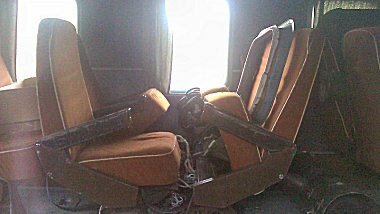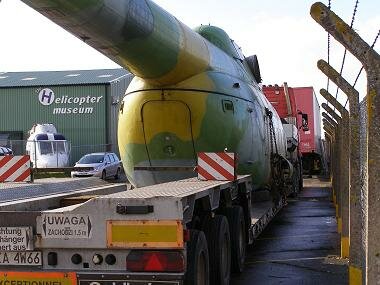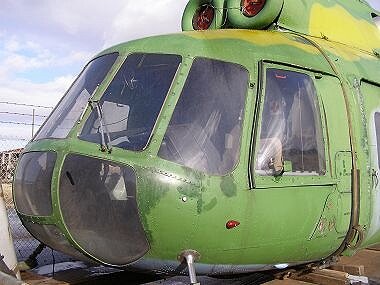|
|
|
|
|
The Mi-8 was designed by Mikhail Mil and about fifteen of the Mi-8P, Mi-8PS and Mi-8S passenger variant helicopters, with rectangular windows, were supplied to Poland. Serial 618 was manufactured in the Kazan factory, in the then Soviet Union, in June 1972 and delivered to the Special Air Transport Regiment (SPLT) of the Polish Air Force in Warsaw, as a Mi-8PS, in the red and white national colour scheme, in September 1972.
It was used, initially, as an executive transport but was later modified to Mi-8P configuration with green and sand camouflage, for use with 37 Air Group, Leznica Wielka, as an air ambulance, an airborne command post and as a troop transport. It was withdrawn from use in 2006 and parked in open storage at Leznica. |
| Mi-8P Serial 618 in 2004 |
|
|
|
|
|
|
|
From 1960 Mil’s OKB were designing a replacement for the 14-seat Mi-4 (also represented in The Museum collection). This was the Mi-8 (“Hip”), a multipurpose, medium-lift, helicopter that was originally intended for use by Aeroflot. They decided to use the Mi-4’s rotor hub, blades and tail boom initially, with a single 2700 shp Soloviev turbine above the fuselage and a 2-seat cockpit in the nose. This prototype first flew in June 1961, the same year as the first Mi-2 flight, and was seen at the Tushino Display in July of that year.
The second prototype, with two 1400 shp Izotov TV2-117 turboshafts and all-metal rotor blades, first flew in September 1962 and was later demonstrated to members of the Soviet government. |
| Mi-8P, Serial 618, as an Air Ambulance in 2006 |
|
|
|
|
|
|
|
A third version, now with five rotor blades and 1700 shp turboshafts, went into production in 1964 having claimed two world speed and distance records. Two years later a civil 28-passenger variant, the Mi-8P with large rectangular windows, entered production. It had a strengthened floor so could be easily converted to carry freight, internally or underslung. A very similar civil version, the Mi-8PS with seating for only 5 or 6 passengers, but with improved facilities and amenities, was introduced for VIP use.
A prototype civil Mi-8P had been on display at the 1965 Paris Air Show, where it was flown by Captain John Cameron, of BEA’s Helicopter Unit. In 1967 Cameron led a BEA team, on a visit to Moscow, to evaluate the Mi-8P for possible use in the UK, in place of the Sikorsky S-61. The team's verdict is understood to have been positive but none were ever purchased for use by UK civil operators. |
|
|
|
| Mi-8PS as a VIP transport in Polish national livery |
|
|
|
|
|
| The Mi-8T and its derivatives soon became the standard Soviet and Warsaw Pact countries' military utility and assault helicopters, some with increasingly varied and heavy weapons fit, though the weight of these armaments, which included rocket launchers and anti-tank missiles, made it necessary to reduce the number of troops that could be carried. Many passenger versions have been sold to civil operators worldwide. The Mi-8 has been used by these civil operators and by armed forces in over 65 countries, including Peru, Poland, Russia, Cuba, India, China, Iraq, Afghanistan and Pakistan. Up to 2006, factories in Kazan and Ulan Ude had produced more than 10,000 examples of the Mi-8, in twenty versions, and at least 7000 of its subsequent, more powerful and efficient, export derivative, the Mi-17. Many later versions of the Mi-8 and Mi-17 were still in use, worldwide, in 2019. |
|
|
|
|
|
|
|
Aerogaviota's Mi-8PS in Cuba in June 2006 |
|
|
|
|
|
|
|
|
|
|
|
|
| Mi-8P, 618, re-assembly |
|
Arrivals and Acquisitions |
| |
|
|
|


